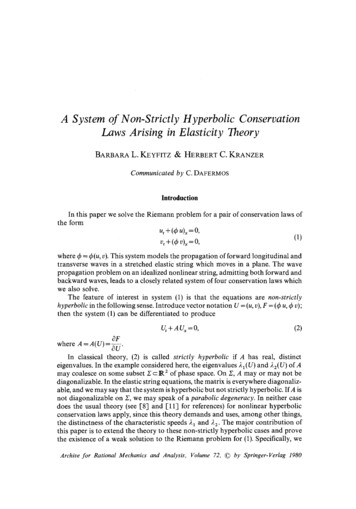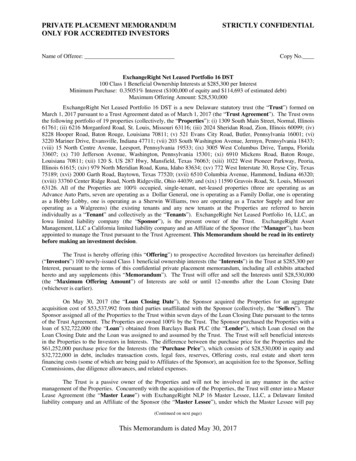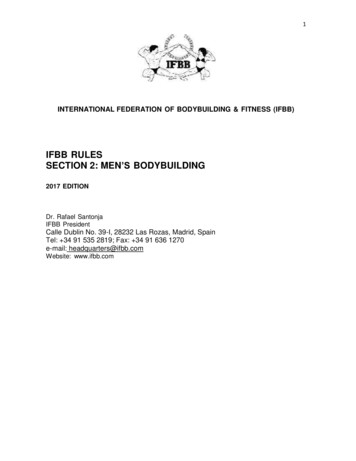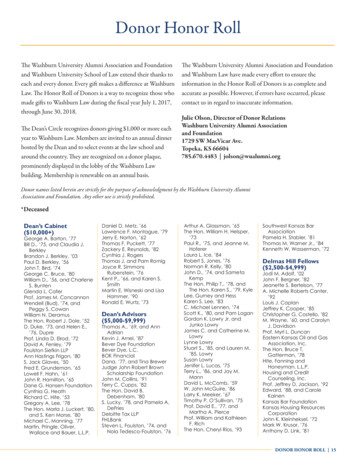
Transcription
A System of Non-Strictly Hyperbolic ConservationLaws Arising in Elasticity 7-heoryBARBARA L. KEYFITZ HERBERT C. KRANZERCommunicated by C. DAFERMOSIntroductionIn this paper we solve the Riemann problem for a pair of conservation laws ofthe formu, u)x 0,v, (r(1)where r q (u, v). This system models the propagation of forward longitudinal andtransverse waves in a stretched elastic string which moves in a plane. The wavepropagation problem on an idealized nonlinear string, admitting both forward andbackward waves, leads to a closely related system of four conservation laws whichwe also solve.The feature of interest in system (1) is that the equations are non-strictlyhyperbolic in the following sense. Introduce vector notation U (u, v), F ( bu, r v);then the system (1) can be differentiated to produceU AU 0,(2)0Fwhere A A(U) OU"In classical theory, (2) is called strictly hyperbolic if A has real, distincteigenvalues. In the example considered here, the eigenvalues 21(U ) and 22(U ) of Amay coalesce on some subset 2 : 2 of phase space. On 2:, A may or may not bediagonalizable. In the elastic string equations, the matrix is everywhere diagonalizable, and we may say that the system is hyperbolic but not strictly hyperbolic. IrA isnot diagonalizable on 2:, we may speak of a parabolic degeneracy. In neither casedoes the usual theory (see [8] and [11] for references) for nonlinear hyperbolicconservation laws apply, since this theory demands and uses, among other things,the distinctness of the characteristic speeds 21 and 22. The major contribution ofthis paper is to extend the theory to these non-strictly hyperbolic cases and provethe existence of a weak solution to the Riemann problem for (1). Specifically, weArchive for Rational Mechanics and Analysis, Volume 72, 9 by Springer-Verlag 1980
220B.L. KEYFITZ & H. C. KRANZERsolve (1) with initial dataU(x,O) { ',x 0,x 0,(3)in the class of functions containing appropriately generalized shock and rarefactionwaves.System (1) is of a particularly simple form a m o n g non-strictly hyperbolic 2 2systems in that one of the characteristic families corresponds to a contactdiscontinuity and hence is essentially linear. Because this is a property also of theelastic string equations, we were motivated to consider this system first. In Section 1we analyse the general properties of (1) and discuss its admissible discontinuitiesand simple wave solutions. Section 2 solves the diagonalizable case and Section3, the nondiagonalizable case; Section 4 covers the application to an elastic stringproblem.1. Model EquationsIn system (1), b is in general a function of u and v; for example, in the elasticstring p r o b l e m we model a nonlinear stress-strain relation byr(r-1) 2 ,where r2 uZ v 2.(4)r(Cf Section4 for a brief discussion of the model as well as for relevantreferences.)F o r general r if we let tan 0 v/u and write r qS(r, 0) in polar coordinates,we find from the differentiated form of (2), with\rthat the eigenvalues of A (characteristic speeds of the system) are) i r0rr162 r 'Then X {(u, v)121 2z} {(u, v)lr r 0}.In the elastic string problem, solutions with r 0 are physically inadmissible,and we shall in general look at solutions of (1) in the punctured plane F, 2 - {0}.Thus S is the set of points for which c /Or O. T o simplify the situation, assumethat 2: is a simple closed curve given by r f(O); that is, er 0 for just one point oneach radial line, L o. This is the case, for example, if r0) is a convex function of rfor each fixed 0 and ]r 0)[ as r 0 and as r o% for each fixed 0. Each pointU L o has a reciprocal point U* eL o on the opposite side of Z"with qS(U) rU*is defined to be 0 or Go if no finite reciprocal point exists.T h e eigenvector w 1 corresponding to 21 is parallel to (-q v, b,), so thatwl. 1721- 0 and hence every shock of this family is a contact discontinuity.
Conservation Laws in Elasticity221\D-ZD*\)rFigure 1Figure 2T h e eigenvector w z corresponding t o 2 is parallel to (u,v), and w 2 9 1722 r ( r b ) , , and so this family is genuinely nonlinear if (rq )rr 24 , r b,r 0. F o rdefiniteness, we m a y assume (r qS),r 0; then, since b, 0 on Z, we see that br, 0 ina n e i g h b o r h o o d of I;. The case (r b), 0 similarly implies qSrr 0 near 2;, and m a n yother inequalities are reversed; when necessary statements corresponding to thiscase will be displayed in parentheses [ ]. See Figure l. T h e conventionalnormalization w 2 9 V 2 0 suggests defining w e (cos 0, sin 0) [w 2 - (cos0, sin 0)].The R a n k i n e - H u g o n i o t equations for (1),s( U - Uo) F(U) - F(Uo) ,(5)can be solved to find the H u g o n i o t locus H ( U o ) c IR 2 of states U with the p r o p e r t ythat the function Uo,U(x, t) U,x st,x st(6)is a weak solution of (1). F o r a given U o (r o cos 0 o, r o sin 0o), it can be verified thatthe H u g o n i o t locus is the union of four sets (see Figure 2):I. U ( r c o s O o , r s i n O o ) , r O , and s 4)(U)r-c (Uo)ror - - 1"oII. U lies on the curve 4)(U) (Uo) through U o and s b(Uo).III. U lies on a curve q (U) q (Uo) which does not contain Uo. (III is e m p t y ifU* II. Otherwise III is the J - c u r v e t h r o u g h U*.)IV. U -(rcosOo,rsinOo), r O, and s - ( v ) r 4)(Vo) ror r oIt is well k n o w n that for hyperbolic conservation laws some restriction isnecessary on the discontinuities allowed in solving the R i e m a n n p r o b l e m ;otherwise there will be in general m o r e than one solution. One criterion foradmissibility is the entropy condition introduced by LAX [11] for genuinelynonlinear systems: a discontinuity must be of the k th family for some k, whichmeans, for (6),
222B.L. KEYFITZ & H. C. KRANZER;tk( V) s ; k(Oo),2i(U) s,) j(Uo) S, j k,s 21(U ),s 2j(U0),(7)j kwhere the eigenvalues are ordered: 21 2 2 . ) n" If the k th family is linearlydegenerate everywhere the first relation reads: 2k(U) S 2k(Uo) and the others areunchanged. LIU [13] extended this condition to systems with local lineardegeneracies. The difficulty for non-strictly hyperbolic conservation laws is thatthere is no well-defined ordering of the eigenvalues in the domain of the problem.However, a statement that is equivalent to (7) in the strictly hyperbolic case andapplies to non-strictly hyperbolic systems is that either (n 1) characteristics enterthe shock and ( n - 1 ) leave it or ( n - 1 ) characteristics enter and leave while theremaining two, which in this case must belong to linearly degenerate families, aretangent to the discontinuity. We shall refer to this rule as the Lax EntropyCondition. For non-strictly hyperbolic conservation laws we shall extend thiscriterion to include points of the Hugoniot locus H(Uo) which are limits of pointssatisfying the above condition. Such points will be said to satisfy the GeneralizedLax Entropy Condition; they constitute the shock set, S(Uo).Theorem 1. The shock set S(Uo) consists of the part of I with r r o [r ro, if(r qS)rr 0], the part of II on the same side of Z as Uo; and possibly a part of IV.Proof. We state the arguments for the convex case, (r qS)rr 0. If Ue I, then s [- r l[r]lies between the values o f (r q )r f t 2 at Uo and U, hence if r ro, 2e(U) s 22(Uo),while if r ro, the inequalities are reversed. In the notation of [8] we call the firstsegment S2(Uo), the second S (Uo). For the characteristic speeds of the oppositefamily,S I(U) s D(U) ro( b(U)( (Uo))r -- r 0ands- ,(Uo) - o ( (u)- (Uo)),and these quantities clearly have the same sign. Thus if r r o, we have threecharacteristics entering the shock and one leaving, but the shock speed may befaster or slower than the opposite family, according as q (U) b(Uo) or b(U) q (Uo). The point U*, with q (Uo) b(U ), satisfies the generalized entropycondition. If U belongs to II or III, the discontinuity is contact, with 21(U) s 2i(Uo). As long as U and Uo are on the same side of X, s - 2 2 ( U ) and s-- .2(Uo)have the same sign. The arc of II so obtained is part of the shock set, and itsendpoints, if any, on X satisfy the generalized entropy condition. We call thisarcR(Uo). On the other hand, for points U on the opposite side of X from Uo (i.e.,points ofII - R(Uo) or of III), s - .2(U) and s - 2z(Uo) have opposite signs, violatingthe Lax entropy condition.There also may be points in IV which satisfy the entropy conditon. Since s liesbetween q (U) and b(U0), we have 21(Uo) S 21(U ) if b(Uo) b(U), that is for allU e l V between the points I V n I I Uo and IVc III U*, if such points exist. Thus a
Conservation Laws in Elasticity223shock of the first family will occur if in addition s - 2 2 has the same sign at U and U o.This will h a p p e n for U in a subinterval (do, W), as can be seen by letting U m o v efrom d o to U*. N o w s - 22(Uo) and s - J,z(Uo) do have the same sign, so we have ashock for points near Uo, while s - ) 2 ( U * ) and s - 2z(U0) have opposite signs. But(s-22(U)) -(r b ) , r - r - r ( s - ) 2 ( U ) ) 0 if s 2 2 , so s - 2 2 ( U ) changes signonly once, while -- (s - 22(U0) ) ( s - 22(U)) ' so s - 22(U0) does not change sign atr r oorall. Thus we get a single interval (fro, W), which we call S2(Uo), in which ana n o m a l o u s entropy shock of the first family occurs.T h e p r o o f of T h e o r e m 1 enables us to classify the entropy shocks in I as fast ifs b(Uo), and slow if s qS(Uo). If U 0 is inside Z [outside if (r qS)r 0 ] , this shock isalways slow [fast], but when U o is outside [inside] I; the shock is fast [slow] for Ubetween Uo and U ' and slow [fast] for U between U and the origin [infinity].The set Rz(U0) of states which can be joined on the right to Uo by a rarefactionwave is also a radial line proceeding from Uo, but in the direction opposite to S2(Uo).In fact, R2(Uo) S*(Uo) , and system (1) is therefore non-interacting in the sense ofSMOLLER & JOHNSON [143: if UlsS2(Uo) and U2 Sz(U1)for sufficiently weakshocks, then Uz S2(Uo).T o establish the nature of the degeneracy at 22, it is necessary to k n o w whether Ais diagonalizable there. At 12, A - 2 1 A - 2 2 0 if and only ifu4), v4), u4) v4)v Oon 22;that is, qb, q v 0 there, or in polar coordinates q5r 00 0. But 2; is defined by therelation br 0, so that we have provedT h e o r e m 2. For the system (1) with (o dp(r, O) in polar coordinates, 1; is definedOF. O by {(u, v)] r q5r 0}. The matrix A - is diagonalizable on 1; if and only if frO 0on 22.Corollary. The characteristic speed 2 (a is constant on 22 if and only if A isdiagonalizable there.R e m a r k s . 1. T h e origin is always a singular point in the sense that all S 2 [R2]curves meet there.2. T h e eigenvectors are w 2 ( c o s 0, sin 0) and w 1 ( - qS , qS,) away from 22. On1;, w I is parallel to w 2 in the nondiagonalizable case, and in the diagonalizable caseWl, when defined on 22 by continuity, is tangent to 22.3. A w a y from 22, w . w 2 0 if and only if v b, - u q 0 or 4 0 0. H o w e v e r , at 22,where 4 0 is always zero in the diagonalizable case, wt need not be o r t h o g o n a l to w 2.An example is the function (o(u,v) (u2W2v2-1) 2, for which 1; is an ellipsecentered at the origin, whereas wl .wz O would force 2; to be a circle.4. Since bis a 2re-periodic function of 0, there must be at least two points on 1; atwhich b0 0 and A therefore diagonalizable. One of these points m a y coincide withthe origin.5. I r A is diagonalizable at 22, then every contact curve of type II is on the sameside of Z as Uo. H e n c e R(Uo) is all of II.
224B.L. KEYFITZ 8,: H. C. KRANZER2. The Diagonalizable CaseIf we assume that X is given by r f(0), then since q r 4:0 away from 22, we seethat all contact discontinuity curves b constant are given by functions r f(O, c)for different values ofc. T o get a global existence theorem we assume that q (r, 0) is aconvex function o f r for each fixed 0 and that [ b(r, 0)[ --, oc as r --* 0 and r - o0. ThenS is b o u n d e d away from the origin. We also assume genuine nonlinearity, that is,( r b ) r r 0 [ 0 ] and hence q r 0 [ 0 ] . Note that 21 b has a m i n i m u m[ m a x i m u m ] at 2;, where b 0, and that 22 is strictly increasing [decreasing] with rfrom 0 to o0, as in Figure 1.T o construct solutions to the R i e m a n n p r o b l e m we note that, by our convexityassumptions on 4), every point (r, 0) has a unique reciprocal point (r*, 0) on L o suchthat q (r, 0) b(r*, 0).Theorem 3. Under the assumptions on system (1) that S is given by r f ( 0 ) and ff)o 0 on Z, and that (r(O)r O, that 0 is a convex function of r for fixed O, and thatkb(r, 0)l -* oo as r 0 and co, there is a centered solution to the Riemann problem (3)consisting of at most four states separated by entropy shocks, rarefaction waves orcontact discontinuities. This solution is unique provided Uz and Ur do not lie ondiametrically opposite rays through the origin.Proof. Assume b 0 for definiteness. Let D - be the region of U-space in which2 1 2 2 , D the region where 2 1 2 2 . Our assumptions guarantee that everycontact discontinuity curve R(Uo) intersects every L o at a unique point.Case I. UI D . If also UreD-, then R ( U ) c D - and Um R2(UI)nR(U ) orS2(UI)nR(U ) is uniquely defined. The solution contains the intermediate state Umjoined to Ut by a slow shock or rarefaction wave and joined to U by a contactdiscontinuity.If U D , then let Um 27NR2(Ul) , Un 27NS2(Ur). Then UI joins U,, by ararefaction wave, U,, joins U, by a contact discontinuity and U. joins Ur by anotherrarefaction wave. (Note that here we are using the non-interacting nature of theshock curves to facilitate finding U,. We should really draw a " b a c k w a r drarefaction curve" from U to intersect S.)Case II. U eD . F o r each point U R(U ) the reciprocal point is U* S2(U)nR(UI*), and R(UI* ) is a closed curve. If Ur and Uz are on the same sideof R(UI*), then Um R(Ut)nR2(Ur) and / /1joins U,, by a contact discontinuity, Umjoins Ur by a fast shock.If Ur and Ul are on opposite sides of R(Ul*), then Um S2(Ut)nR(U ) and Ul joinsU,, by a slow shock, U,, joins Ur by a contact discontinuity. Note that when Ur isnear R(U *), Um is not a continuous function of Ur.If Ur lies on R(UI*), Um m a y have either of the above forms, but the solutionU(x, t) is nevertheless unique because the shock and contact discontinuity thenhave the same speed of p r o p a g a t i o n and so the sector of the x, t-plane in which U Um has zero width.Uniqueness. With one exception the solutions obtained above are the onlycentered solutions which satisfy the Lax entropy conditions at discontinuities, for it
225Conservation Laws in ElasticityZ\UFigure 3m a y be verified that in each case there is no other sequence of states Uz, U1,U 2 . Uj, U that can be joined by a sequence of waves with increasing speeds. F o rexample, if Ut joins U 1 by a contact discontinuity whose speed is q bt b1, thenU 1 can join U 2 only by a fast shock or rarefaction wave, and then only if2 2 21, etc.The exception is that if Ul Lo, U, L o and is such that U Sz(U ), there m a y bea second type of solution, in which Uz is joined to a point UmeSz(U ) by ana n o m a l o u s e n t r o p y shock, while Um either equals Ur or is joined to U, by ararefaction wave. Since a state U,, S2(U ) is continuable only to a n o t h e r point inLo , a n o m a l o u s shocks can a p p e a r only for pairs of points Ut, Ur that arediametrically opposite. F o r the elastic string, this corresponds to a stringcompletely bent back on itself. Such a R i e m a n n p r o b l e m is thus ill-posed.3. Local Solution in the Nondiagonalizable CaseIf the matrix A is not diagonalizable at Z, various possibilities presentthemselves. An example which we have considered in detail is q (u, v ) [(u 1) 2 v 2] P,where p is a positive or negative exponent. H e r e Z is the circle (u 89 v 2 88T h e matrix is diagonalizable at the points (0, 0) and ( - 1, 0), b o t h of which aresingular for the system. F o r the general equation of this type, a global solutioncannot be described without a detailed knowledge of the b e h a v i o r of q away from2;, and also of the character of the (at least two) diagonalizable points of Z.In this section, we construct a solution to the R i e m a n n p r o b l e m in then e i g h b o r h o o d of Z. Specifically, we take an open d o m a i n F of IR 2 which is dividedinto two connected subsets D - and D by a segment of 27 on which b0 :# 0. F o rdefiniteness we b o u n d F by two radial line segments, so that in F 0min 0 0m,x. Weassume, as in the previous sections, that 2; is given by r f ( 0 ) in F. The a s s u m p t i o nof genuine nonlinearity on the 2 2 family, as we saw, implies thrr 4 0 at Z. W e alsohave 4 0: 0 at 2;. Thus the curves b-- constant have second-order contact with linesL o at 27, and the curve b constant going t h r o u g h (f(0max) , 0max) or (f(0min) , 0rain)b o u n d s a convex region within the sector (0rain, 0m,x) and intersects the other radialline in two points. D e n o t e the interior of this region by F. See Figure 4.W i t h o u t loss of generality, we can take the b o u n d i n g curve to pass t h r o u g h 0 . . . .and assume b0 0, br 0. The cases b0 0, br 0 and the two cases involving 0mln
226B.L. KEYFITZ 8r H. C. KRANZERy ninCDCurveu\Figure 4 Fest ShockSlow ShockFigure 5are similar. Thus 4) attains its m a x i m u m in F on the curved arc, its m i n i m u m a t 0mi n.On each Lo, 4) attains a m i n i m u m at 2;, and 22 increases with r as in Figure 1. Asbefore, D - { U[21 22} is inside 2; (i.e., smaller values of r) and D is outside 2;.The part of the H u g o n i o t locus H(Uo) in F is the union of the two curves 4)(U) 4)(Uo) and O(U) O(Uo).Define the wave set W(Uo) to be the set of states U which can be connected onthe right to the state U0 on the left, either by a rarefaction wave or by a shock orcontact discontinuity satisfying an entropy condition on both families. In thepresent problem this set is a subset of H(Uo), since the system is non-interactive.The continuable set C(Uo) is the subset of points U of W(Uo) which can also bejoined to a third state on the right by a rarefaction wave, shock or contactdiscontinuity whose m i n i m u m speed is at least as great as the m a x i m u m speed ofthe wave joining Uo to U.The two-related set W2(Uo) is the set of states which can be joined to U0 via twowaves of the listed types: i.e., the union of the appropriate portions of the sets W(U)for all U in C(Uo), or the set of continuations of continuable points.Higher-order continuable sets Cj(Uo) and j-related sets W (Uo) can be similarlydefined.Now, as in the diagonalizable case, Uo (ro, 0o) can be joined to any point U (r, 00) on Loo by a shock of speed s [r 4)]/[r] if r to, and this is a fast shock if4)(r) 4)(ro) and a slow shock if 4)(r) 4)(to). The same point Uo can be joined to Uby a rarefaction if r r o. The head of the rarefaction has speed 22(r) and the tail hasspeed 22(ro).Also, U0 can be joined to a point U by a contact discontinuity if 4)(Uo) 4)(U)and U lies on the same side of X as Uo.Thus in Figure 5 where Uo e D , W(Uo) consists of the segment of the line 0 0oinside F and the segment of the curve 4)(U) 4)(Uo) inside D w I;. The continuableset C(Uo) is the "slow s h o c k " portion of the shock curve and the contactdiscontinuity curve. D e n o t e the point of intersection of 4) 4)(Uo) with 2; as U1. Itcan be seen that the set W2(Uo) consists of the entire D - region and the part of D between 0m . and 0(U0; this is obtained by continuing the slow shock by a contactdiscontinuity and the contact discontinuity by a fast shock or rarefaction wave.N o t e that if U* is on 2; with 4)(U*) 4)(U ), then Uo can be joined to U* t h r o u g han intermediate state TeD- by a slow shock of speed s 4)([7) and a contactdiscontinuity of speed 4)([7) 4)(U*). But n o w U* can join any point on Lo(v, ) withr r(U*) by a rarefaction wave of tail speed 22(U* ) 4)(U*), and hence U* e C2(Uo).
Conservation Laws in Elasticity227onR(U2)\ S l o w ShockuFigure 6[/ / t XI &2\ k,',,7i/I/ / //I t\. / ][ / /11 I ' ', ."/11 I/iI ,VIt//]iI I ,,\ / ,/Y',t','ti/ \ , ' h' //i lV i,z2cuQ),. ,,%/ A' )(,'li I/!. i J z (ul:,' .,.-%., " \,4,qi Ii/'t,4,/ iX",\X/I//#I',\U\\Figure 7Thus the remainder of s consists of points in W3(U0). Since none of the regionscovered by different solutions overlap, the solution is unique.If UoeD-, as in Figure 6, the analogous construction is as follows. W(Uo)consists of the line 0 0o and the segement of b 0(U0) in D - . Define U1 as before,and let U2 be the intersection of Z with Loo. Only the (slow) shock and the portion ofthe rarefaction curve inside D - u Z are continuable, together with the isolated pointUt. The rarefactions with UeD § have the odd feature that the so-called cross-flowcharacteristic family (in x, t-space) does not cross the wave but instead flows into itfrom both front and back (see Figure 7 where cross-flow is in dotted lines). Suchwaves are neither continuable nor continuations of other waves, and hence may beexpected to appear only for very special initial conditions Ut and U,.The set W2(Uo)consists of the part of D - with q5 (U2) and the line 0 0(Ut) inD § of points joined to U1 by a rarefaction wave, together with the curve R(U2) in D ,points of which can be joined to U2 by a contact discontinuity of speed q (U2)equalto the head speed of the rarefaction wave joining U0 and U2. The set C2(Uo) consistsof points of Z with 0 qS(U2) and the curve R(Uz)nD . F r o m the latter fast shocksand rarefaction waves, from the former rarefaction waves alone may be drawn, sothat Wa(Uo)just fills the remainder of F.Thus we have provedTheorem 4. For the system (1), assume that Z is given by r f(O) in the sectorOmi n 0 Omax and that in this sector (r c ),, 0 everywhere and C o : 0 on Z. Let F
228B.L. KEYFITZ 8r H. C. KRANZERdenote the subset of this sector bounded by one of its radial bounding lines and by the 4) const, curve tangent to the other bounding line at I,. Then the Riemann problem (3)has for all Ul, U in F a unique centered entropy solution U(x, t ) c F. The solutionconsists of at most four constant states separated by discontinuities or simple waves.It is noteworthy that in this problem a solution cannot be found by restrictingattention to one or the other side of-r where the equations are strictly hyperbolic.Intermediate states on the opposite side of r may be necessary to join two points onthe same side.It is also clear that the above construction can be carried out in any regioncontaining only non-diagonalizable points of 2;, and such regions may be piecedtogether. However, singular behavior will occur at the diagonalizable points on 2;.4. Application to a Problem of Shocks on an Elastic StringWe consider an elastic string of infinite length which is constrained to move inthe (w, v) plane. See [2], [7]. Let x be arc-length along the string measured fromsome origin when it is in a reference configuration of uniform tension To and densityPo, and let w(x, t) and v(x, t) be the horizontal and vertical components at time t ofthe point which was at distance x from the origin in the reference state. Thisnormalization is convenient for studying the Riemann problem.The strain is defined as e - -- 2- 1 2,and we let2r l z ,20 anAssuming a stress-strain relation T T(e), we can write the equations of motionof the string (see CRISTESCU [5]) in the form ?2wc3 ( TPo at 2 -- X - Xa2v a ( rPoZ v(9)'&) 9String ConfigurationxoF c w)"1Reference Configuration" wFigure 8Figure 9
Conservation Laws in Elasticity229T o avoid proliferation of symbols, we let Po 1 and To 1, and let b qS(r) T1 "Define vector functions U (wx,w,v ,,vt) and F(U) (-wt,-dpwx,-vt,-(ovx).Then we have a system of four conservation laws of the form of equation (2). Theeigenvalues of A are l / 2 1 and l/ de- (r b) "t-2 2. Thus theequations are hyperbolic if Tis positive and m o n o t o n e , but non-strictly hyperbolicdif, for some value of r, q rr(r b), or r br 0. Positive tension is a necessaryhypothesis, and it is also physically reasonable that stress increase with strain. F o r astress-strain relation that is linear near the reference position, T 1 a e, so 4 (r) a 1 -aand q5 -1 -a.r2 is zero if and only if a 1. Thus in the linear a p p r o x i m a -rtion we have a characteristic equation with roots of constant multiplicity if a 1and distinct roots i f a 4 1. If, however, Tis nonlinear, then near the defining state wem a y write T( ) 1 a e 6 e 2 O(e3), and (1 ) - - T a - 1 2 6 e O(e 2) willt*G1--obe equal to zero for some e which is near zero for a near 1. Since the choice ofthe reference state was arbitrary, we choose it to correspond to this critical value:that is, a - ( 0 ) 1. Thus A will have an eigenvalue of multiplicity two if e 0(r 1).u 6 ( r - 1) 2F o r example, if T(e) is exactly 1 e 6 e 2, then q5 1 - rIt is stated in CRISTESCU [5] that the speeds ] / are characteristic of thep r o p a g a t i o n of transverse waves, or of changes in the shape of the string withoutchanges in tension. This family is linearly degenerate; that is, a discontinuity in U,which is, physically, a corner in the string, p r o p a g a t e s as a contact discontinuitywith the same speed as the c o m m o n value of 1 / ahead of or behind the corner.1/dT1The speeds - 1/d-- -.characterize longitudina or tension waves, in which there is nochange of shape in the string. A discontinuity in this family is a tension jump,analogous to the pressure j u m p in the equations of gas dynamics [3], a n d suchdiscontinuities are shocks in the sense of this work. The condition for genuined2dZTnonlinearity is reduced to Srz(r b) 4 0, or -d 5-e24 0, a condition we shall assume inthe region of interest. W e shall also assume that the only physically relevant oradmissible discontinuities are those which satisfy the L a x entropy condition (or aweakened condition with non-strict inequalities). In A p p e n d i x B we present ana r g u m e n t based on the total energy in the string to support this m a t h e m a t i c a l l yreasonable assumption. However, it must be stated that the equations (9) for thestring are an idealized system which describes an infinitely thin string. We shalld e m o n s t r a t e in the t h e o r e m of this section that the generalized Lax entropycondition m a k e s the R i e m a n n P r o b l e m for (9) m a t h e m a t i c a l l y well-posed, but thesolutions we find are physically meaningful only if it can be shown that they are
230B.L. KEYFITZ : H. C. KRANZERindeed the limits of solutions of the m o r e complicated mathematical systemcontaining all the physically relevant quantities. This limiting procedure wouldserve to define a length scale on which shock thickness could be measured. As far aswe know, this framework does not exist at present; however, shocks in elasticstrings are observed experimentally and are important in some engineeringapplications (see I o s u E [7], CR1STESCU [5]). It would be interesting to know thecircumstances under which the solutions found here describe the observedphenomena.In the problem we have just outlined, we shall assume genuine non-linearity,d2that is ) r2(r q5)#0. N o w if r is convex downward, then rqS, and hence b, mightbecome negative as r--*0 or as r--*0% and the equations would no longer behyperbolic there. Also, if (r b)r becomes negative for some values of r the equationsare not hyperbolic there. Thus we will consider only states U corresponding tovalues o f r in an interval rmin r rmax in which band (r q )r are positive. N o t e that astate U (ul,Uz,U3,U4) is completely specified if r ] / u l 2 u , 0 t a n -1 (U3], u2and u 4 are known.\ullThe solution to the R i e m a n n problem with initial states Ut, Ur will consist of fivestates Ut U0, U 1. , U4 Ur, joined by two b a c k w a r d and two forward waves.As in Section2 we define X {U[(a (rO)r} {U[r l}; T, is a 3-dimensionalmanifold in lR 4 which separates D- {U[q (r b) } from D {Ul(a (rO)r}.F o r definiteness we shall take (r b)rr 0; then D {U[r l}.To find the wave curves we must solve the R a n k i n e - H u g o n i o t equationss[U] [F], orS2[Ul] [(/)N1], 2 [U3] [ U3].Following the discussion in Section 1, with s 2 replacing s, we find that there aretwo types of waves: contact discontinuities with r r and s 2 qS(r ) q (r ),and shocks with 0 0and s2 --.[r b] There are also, as in the model problem,-[r]a n o m a l o u s shocks, with 0 0 ,which correspond to cusps, or 180 bendsin the string. W e do not include these in the construction. See the discussion atthe end of Section 2. The backward shocks, with s - ([r b]/[r]) 89 0, satisfy anentropy condition on the characteristic speed of the same family if - 2 - s - 2 or r r ; all such shocks satisfy the entropy condition on the otherfamily, and as in Section 2, the shock is slow if [s] 2 , i.e. s -]/dp -, and fastotherwise. F o r each point r define the reciprocal point r* such that q (r) b(r*);since r 1 is a m i n i m u m of b, such a point always exists for r near 1, and we letr* be 0 or oe if no finite reciprocal point exists for r 1 or r 1, respectively.There are the following possibilities:Ifl r r o%Ifr r r* ,If r r * r ,s is a fast shock.s is a slow shock.s is a fast shock.Similarly the forward shocks, with s ([r q ]/[r]) , satisfy an entropy condition if22 s 2 or r r and if
Conservation Laws in Elasticity1 r r 0,s is a slow shock;r r* r ,s is a slow shock
endpoints, if any, on X satisfy the generalized entropy condition. We call this arcR(Uo). On the other hand, for points U on the opposite side of X from U o (i.e., points ofII - R(Uo) or of III), s - .2(U) and s - 2z(Uo) have opposite signs, violating the Lax entropy condition.











